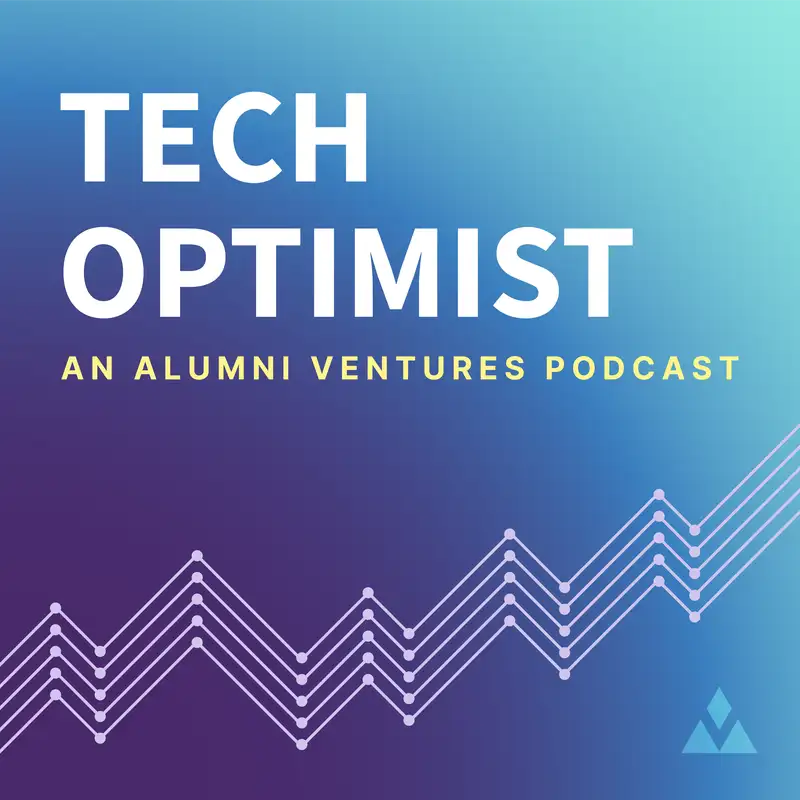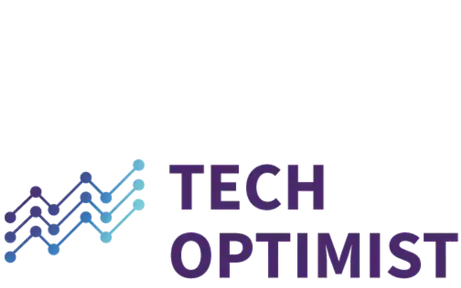#71 - Blue Flame Thinkers: Russell Hannigan
Samantha Herrick:
This is a podcast brought to you by Alumni Ventures. Welcome to the Tech Optimist. This is a podcast where we tell you the stories of the people creating tomorrow.
Russell Hannigan:
In space, the companies are being asked to basically build a railroad every time they go to space.
Samantha Herrick:
That is Russell Hannigan, space executive and entrepreneur.
Russell Hannigan:
Yeah. They rip it up and they build another one in place. That's traditionally what has happened. And so we need to get to a place where to try and build that true railroad to space to benefit everybody.
Mike Collins:
You have to go to the Wild West and...
Samantha Herrick:
You know that voice. That is Mike Collins, co-founder and CEO at Alumni Ventures.
Mike Collins:
Space is that for me, it's kind of unlimited upside and potential. Really, really hard problems.
Russell Hannigan:
Yeah.
Samantha Herrick:
It is also worth noting some historical costs of space innovation. And that's me. My name is Samantha Herrick and I'm the guide and editor for this podcast. NASA spent approximately $10.6 billion in the 1970s, so the 1970s dollars, to develop the space shuttle program. And by the end of the Space shuttle program, each flight costs roughly $766 million. All right, so we're going to do a quick little intro to this episode. This is our second installment of the Blue Flame Thinkers type of episode for the Tech Optimist. And with these, I take a backseat. I tend to like the conversation, just have it be natural, so I won't be butting in too much today. But I wanted to provide a few words on our guest, Russell Hannigan. He's got quite a career and I want to share some aspects of it with you.
So if you haven't gathered as of now, Russell Hannigan is a very notable figure in the commercial space industry. He was the founder and CEO of EarthNow, a satellite imaging startup that emerged from stealth mode in 2018. EarthNow aimed to deploy a large constellation of advanced imaging satellites to deliver real-time, continuous video of almost anywhere on earth. So the company secured investments from high profile backers, including Bill Gates and just so many others. EarthNow plan to use an upgraded version of the satellite platform developed for one web's communication service. And the goal is to provide real-time video with delays as short as one second, a significant improvement over existing earth observation systems.
So he's provided countless insights on the emerging commercial space industry, you'll hear a lot of them today in the conversation. He's noted that hyperspectral imagery is still in its infancy in the commercial space domain, suggesting significant potential for growth and innovation. Now, his career demonstrates a focus on advancing earth observation technologies and bringing innovative space-based services to both commercial and government customers. His work spans from real-time video imaging to hyperspectral sensing, positioning him as a significant figure in the evolving commercial space industry. But for now, we're going to hop into an ad and then we're going to jump range the interview. So hang tight, sit back and enjoy. I'll talk to you in a few seconds.
Speaker 4:
Exceptional value creation comes from solving hard things. Alumni Ventures Deep Tech Fund is a portfolio of 20 to 30 ventures run by exceptional teams who are tackling huge opportunities in AI, space, energy, transportation, cybersecurity, and more. These game-changing ventures have strong lead venture investors and practical approaches to creating shareholder value. If you are interested in investing in the future of Deep Tech, visit av.vc/deeptech to learn more.
Samantha Herrick:
As a reminder, the Tech Optimist podcast is for the informational purposes only. It's not personalized advice, and it's not an offer to buy or sell securities. For additional important details, please see the text description accompanying this episode.
Mike Collins:
So welcome to this episode of the Tech Optimist podcast. This is our Blue Flame Thinkers program, and I'm really honored to be joined by Russell Hannigan today. And we're going to talk a little bit about space. Obviously, a lot of us have watched Elon Musk, had a big week and a big kind of, "Oh my God," moment, just in the last few days. And I think it's, the timing is perfect for us to get kind of state of play of what's going on in space technology. So Russell, welcome to the show.
Russell Hannigan:
Thank you very much. It's an honor to be here. Thank you for the introduction.
Mike Collins:
Yeah, Russell, tell us, again, here we are in the fall of 2024. It seems like a very exciting time in space. What do you think are the three or four big things going on right now?
Russell Hannigan:
That's a great question because there's a lot more than three or four, I suppose.
Mike Collins:
Yeah.
Russell Hannigan:
I mean, clearly yesterday was an incredible moment. I would argue that it was one of the most impressive, if not the most impressive engineering accomplishments ever. And not just because it's an accomplishment, but because of what it's trying to achieve. And that is the first fully reusable transportation system. So that is head and shoulders above everything else.
Samantha Herrick:
Here, if you haven't picked up on it already, Russell is talking about the Starship Flight 5, which is featured in episode 69 of this podcast.
Russell Hannigan:
So in addition to that, of course, there are so many different ventures, everything from direct to sell communications, it's a big topic right now to mining Helium-3 on the moon. I mean, think of anything really, and someone, some entrepreneur or some innovator out there's trying to figure out, "How can I make a business in this particular area?" And space is incredibly cool, but it's also got to make money. And that's where I see things and I try and look at things, try and separate the cool factor from the fact that I want a good return from this, I want a great return from this. And that's where a lot of the challenges are coming today is there's some great fantastic stuff, but how are they going to make money, right? A transition point right now in many ways.
Mike Collins:
Yeah. I mean, one way I've thought about it too is a lot of times there's a big investment. In other technologies you've seen the kind of government go through kind of wave one, and then you see the private sector, public sector partnerships with building infrastructure, whether this was the internet, whether this was the railroads, and then those infrastructure plays really then unleash the garage entrepreneurs. And it seems to me that space is such a huge opportunity, but we're transitioning now from deep science, government funded, RND to where we're starting to see applications and infrastructure and some backbone now where entrepreneurs can really be unleashed. So how would you build on that?
Russell Hannigan:
Yeah. They definitely can, but they still have one very, very big hurdle, and that is the cost to get to and from space.
Mike Collins:
Yeah.
Russell Hannigan:
It is simply enormous. You mentioned the transcontinental railroads, and it is really interesting that in today's dollars, the two companies that built the railroads were paid about one and a half million dollars per mile to do that, right?
Mike Collins:
Yeah.
Russell Hannigan:
They were told what kind of rails to build and how far, it's standard, but they were said, "Here's one and a half million dollars for every mile you build in this case mountain." That's difficult areas. And, "Oh, by the way, we're going to give you this land grant that's equivalent to the size of Texas."
Mike Collins:
Yeah.
Russell Hannigan:
So that paved the way to allow California to exist. And all the commerce that happens today in space, the companies are being asked to basically build a railroad every time they go to space and they rip it up and they build another one in place. That's traditionally what has happened. And so we need to get to a place where... And that's why yesterday was so significant and everything that's been happening in the reusable spaces to try and build that true railroad to space to benefit everybody. And so that's still taking its time, but it's coming finally.
Mike Collins:
Yeah, no, and again, there was promise yesterday with just that. And I think people have seen, "Oh, these things have landed in the ocean before. I've seen these landings." But I think, I believe yesterday was, I don't know, 30 times as big or something. It was one big ass rocket that took off and landed yesterday.
Russell Hannigan:
Physics is physics, engineering is engineering. If the numbers add up, they add up, right?
Mike Collins:
Yeah.
Russell Hannigan:
So SpaceX has successfully landed a Falcon 9 Booster more than 350 times. They know how to do it. And so it just extrapolates to something a little bit bigger, a little heavy, yes, incredibly impressive. It's kind of energetic. But it's not like it's the first time they've done that. And that's the beauty of any reusable transportation system is that you've done it before, we've learned from it, we can do it again. And space has been, and this has been a bit of a hobbyhorse for me for the last 30, 40 years, is, "Boy, I'm throwing away this massive capital investment every time I go to space. And how do I know it's going to work?" Well, I know it's going to work because I spend a lot of time and effort to make sure it works. It just leads to something very expensive.
And so this industry as fantastic and dynamic and diverse as it is, I believe it's just the tip of the iceberg because it's got this massive roadblock, this incredibly expensive first cost you have to pay. And the impacts of that going forward are even more enormous. So that's how I'm looking at the world is, "Who are the players out there that are going down that path?" And it has to be more of the space. We're all capitalists. We want competition. We want the best we can get. The other side of the space industry for all of the incredible numbers and pick your consultant and choose your number and how big it is. But with the exception of communications, almost all of it is government is the customer.
That's true on earth observation, it's true of everything else you can think of, human infrastructure and so on. There are things that are happening on the margins that suggest that there's demand there, but it's still government funded. We need to get away. I mean, that's great as a company, government as your customer, absolutely nothing wrong with that. But if we really want the space industry that we want, then we need commercial applications and customers. We need it to grow. We need to be vibrant, we need to be self-supporting 90 plus percent of your revenue comes from the government. I don't believe there's a sustainable position. You're not of return if that's what it's going to be. I mean, again, you can create a good business and do great things for everybody. There's nothing wrong with that. But again, if you want the kind of multiples we see on earth, so to speak, then you need that dynamic customer base, the [inaudible 00:12:33].
Mike Collins:
Communications is an obvious area where I think there's been Starlink, there's been some incredible businesses being created. What do you think are the pockets of commercial opportunity beyond... Clearly there's infrastructure. How do we crack the biggest problem, which is how do we get there safely, repeatedly, affordably, more and more? That would be one, I guess, right? Communications would be two. What other areas do you think are on the list of potential here?
Russell Hannigan:
There's a few. One that I wrote about recently is in the area of materials processing, basically making stuff in space, whether that's pharmaceuticals or fiber optic cables. There are things you can do when gravity is taken out of the equation like pressure or temperature, whatever. It's another parameter. And there's been a lot of really incredible research been done. That's pretty much all they do on the space station is microgravity research. And so wouldn't that be great if we could actually make stuff in space that you can't make on the ground? But the challenge is, again, as I described, is it's just so expensive though. As an example, the cheapest way to get 200 kilograms into space is on a Falcon nine, right? It is by far, by the least expensive way, and it's 1.2 million.
The cost of the spacecraft on top of that is going to be at least 1.2 million for reasons I can talk about later. So right there you have a bogey of two and a half million dollars, but of that 200 kilograms that are just flown, a tiny fraction of that is the actual thing I'm making in space because I need solar panels, I need a heat shield, I need electronics, all this stuff, tiny. So at the end of the day, I'm adding about half a million dollars per kilogram to the cost of the product I'm making. There's almost nothing-
Mike Collins:
Nothing, yeah.
Russell Hannigan:
That needs to be made in space. There are things that are that expensive, but there's nothing that needs to be made in space at all, there's almost nothing. And there's always exceptions, such as. And so you have this fundamental problem is, "Yes, I can do it. And yes, there's a lot of research out there and some just tremendous work, but if I want to make something that I can sell to a customer, I cannot do it at half a million." And that's really optimistic. It's usually much, much higher than that.
Samantha Herrick:
With this topic, I want to provide a little bit more context on, "How expensive is expensive?" Russell and Mike are talking about how these ventures for some entrepreneurs and some innovators can be upwards of millions and billions of dollars. So I'm going to provide a few examples and a few price tags to sort of help all of us gauge how expensive this field is. So traditional launches, they used to cost hundreds of millions of dollars, but SpaceX's Falcon 9 Rocket now offers launches for around $62 million, still insane, like "Just $62 million." But whereas larger rockets like SpaceX's, Falcon Heavy can cost upwards of $90 million per launch. And NASA's Space launch System or SLS is still extremely expensive, estimated at over $2 billion per launch. And as far as launch vehicles, reusable launch vehicles, using a reusable rocket can be up to 65% cheaper than traditional single use rockets, clearly.
Companies like SpaceX, Blue Origin and Rocket Lab are leading the way in reusable rocket technology. Reusability spreads development and manufacturing costs across multiple missions similar to commercial airplanes. Now, as far as satellite technology, this is a whole venture. The admin of CubeSats and small satellites has made space missions more accessible to startups and universities. Miniaturization of satellites has significantly reduced costs as far as just investment trends in this field. In 2023, space Tech drew $12.5 billion in investment. In the global space economy expanded to, okay, this is a real number, to $546 billion in 2023 and is projected to reach $1 trillion by 2040. Those numbers just don't feel real, right? It's really hard to contextualize that, but it is also worth noting some historical costs of space innovation.
So NASA spent approximately $10.6 billion in the 1970s, so the 1970s dollars to develop the space shuttle program. And by the end of the space shuttle program, each flight costs roughly $766 million when accounting for overhead costs. So while innovation in space travel remains expensive, several factors are it more accessible, like decreasing operational costs due to technological advancements, we can thank SpaceX for a lot of that. Expanding market potential and projections of significant growth, strategic importance of space technology and defense. And in conclusion, while innovating in space, travel still requires substantial investment, the costs are decreasing and the potential returns are increasing. The combination of technological investments, private sector involvement and growing market opportunities is making space innovation more accessible than it ever has been before.
But I really liked Russell's point here where he sort of talked about how this could be an obstacle for some innovators, some entrepreneurs in the space. So just imagine if in a few years time or a few months time when all of this technology and innovation gets more and more accessible, how many more people and how many more geniuses are going to have access to this technology and then therefore innovate themselves. So it's just something really cool to think about. And yeah, let's get back into the show.
Russell Hannigan:
And I think again, once that cost to launch comes down by a factor of 10, factor of 25, maybe a factor of 50, then that's when you're going to see things flourish and it's going to be... I'm very excited about what can happen in space.
Mike Collins:
I mean, I think the other side of that equation is we have to get it cheaper to get stuff up there, and then we have to have more leverage when we're there, meaning I think we're going to have to count on some technologies that can kind of automate, robots making robots kind of thing. It's robots and AI getting orders of magnitude better as well. That could potentially be on the other side of this equation too, if there's a asteroid asset and if we can create a package that can co-op and basically do what is necessary to build a factory there. But these are really tough, thorny problems that are going to take time. But I tell 20 somethings that are interested in building a career over the next 50, 70 years in investing. You have to go to the wild west and space is that, for me. It's kind of the unlimited upside and potential, really, really hard problems.
Russell Hannigan:
Yeah.
Mike Collins:
But if you can crack hard, things are hard, but create enormous value when you figure them out. And I think space is almost the ultimate example of that for humans.
Russell Hannigan:
It really is. It is very, very hard, right?
Mike Collins:
Yeah.
Russell Hannigan:
But so was the jet engine five years ago, the internal combustion, 200 years before that, I wish there was the equivalent of the Wild West and the Conestoga wagons. I really wish there was a way to get to space with those kinds of dollars. But what we're seeing is the wild west, the frontier people having, to take a Learjet effectively to do something. I'm actually a really strong believer in human spaceflight. I think we're the best robots out there, so to speak. We have the ability, the intuition, the creativity to do things, but only 700 people have ever been above the Karman line. So if you really want to think about the metric of where we actually are in space or where we are in any business, it's how many humans are actually in the loop.
Mike Collins:
Yeah.
Russell Hannigan:
And that'll happen. I'm interested in the companies that are pursuing those kinds of... Vast example as a company, they showed their Vast two space station today, and that's definitely a step along the road to just these incredible facilities that we want to give a lot of people. I want 70,000, 7 million people in space and what they can do and what we're doing today are night and day. I mean, it'll be extraordinary.
Mike Collins:
I mean, I think that's one thing from the last week that I think we all have to just take a step back and objectively acknowledge. You can like, hate despise, adore Elon Musk, but he had a hell of a week and he thinks big. And the human species needs people who are willing to think big, take on big, audacious, hairy problems and fail a lot. But I do think it's always worth reflecting on dreaming big, thinking big, taking on really hard problems that could take a decade or 20 years to solve.
Russell Hannigan:
Yeah.
Mike Collins:
I do think we have to tip our cap to those people who are at least trying to solve big, big problems.
Russell Hannigan:
It's extraordinary. And to carry the people with you in that shared vision, the vision has always been there for SpaceX. They want to be multi-planetary, right? To be multi-planetary cannot just be multi-planetary on day one. You got to do the steps to get-
Mike Collins:
The steps, yeah.
Russell Hannigan:
And the first step to there is the path towards reusability and space transportation system as well as applications like Starlink that generate revenue that allow you to be a going concern. There's no point in having a big vision if you can't pay the bills. So you got to do both simultaneously and keep both of those in focus. And there are other companies out there that hopefully will challenge there. They're a long, long way behind, but in my backyard with Blue Origin, the line rocket will hopefully fly in the next few months. That is an enormous rocket. Have you ever seen with side by side with a Saturn 5? It's not a lot smaller, it's smaller than Starship, but it is enormous, first stage feasible. Again, a step on that path.
Mike Collins:
Right. And again, it points to the fact of two, of we need do need competition. We do need people trying different approaches, different technologies, different platforms. We've seen that so many other sectors that it really takes that competitive spirit to move everybody forward.
Russell Hannigan:
It really does. And I see it almost every day. Another space venture of some sort is launched or financed or whatever, and that's super exciting. So everybody wants that to happen and yeah, we're seeing that now.
Mike Collins:
So tell me about what are you working on? Where's your heart and passion these days, Russell?
Russell Hannigan:
My heart and passion has always been what we do in the space and trying to make it self-supporting, to be honest. I took a little bit of a sabbatical. I haven't worked for almost four years. I'm advising some companies, one company in particular I'm very excited about that addresses some of these challenges. So I have a lot of experience spending. I started as a physicist by education, I became engineer. I worked on geostationary satellites, I worked on reusable launch systems, small launch vehicles, had my own earth preservation company. I was lucky enough to help create and incubate a number of startup companies that have gone on and been super, super successful. So any way that I can help push the ball forward a little bit, I think my experience might be useful in that regard. I do look at things very, now, critically is the wrong word, but it's how am I going to make money out of this?
Mike Collins:
Who are they?
Russell Hannigan:
How do I differentiate? How do I beat the competition that's coming? All those kinds of things. How does the business plan support? And there are a lot of great businesses out there. There's some that just blows my mind that they've been able to get investment and yet they have. So I'm not the smartest person-
Mike Collins:
And most of them won't turn out. They won't turn out. But occasionally, and this comes from my own life experience of humility, sometimes I'm shocked too. This is like there are companies that I go like, "That's wacky. How did that ever get funded? That team does not have the backgrounds and sense," and you wake up seven years later and they've really surprised you.
Russell Hannigan:
Yeah, don't underestimate the ability of entrepreneurs to innovate.
Mike Collins:
Yeah, right. Including their original businesses or ideas.
Russell Hannigan:
The beauty of, again, what we do on earth, it's a weird way of saying it, is that we try stuff and we can change directions quickly. If it doesn't quite work, we can modify, do that. With space, you're kind of on this five year, a hundred million dollar...
Mike Collins:
I see a card.
Russell Hannigan:
You can't just change directions. You're kind of stuck with what you've got. I want space to move in the other direction. I want it to be that if I'm an engineer building a new kind of mirror or a new kind of sensor or a new kind of antenna, I want that person to be able to take it to space next Thursday. I know that's a big leap, and I know we're doing that today, but that future is coming one way or the other. It's coming. And yesterday was an example of, "Boy, that time really is coming." It's not just something science fiction authors about. We will get to the place where we're flying people to and from space every day. That is common.
Mike Collins:
And that's when we really see the geometric stuff. When we can get this into the garage with two people with a good idea, can actually do something. This new and innovative and special. We're not quite there yet, but it's promising the path we're on for sure. What are a few of the things that, again, just are educated but curious audience should be looking for over the next year? What should they be? Keep your eyes open for this.
Russell Hannigan:
Well, I would keep my eyes open for a few of the launch companies. Stoke is a company that I advised right at the beginning when they were starting, not advising them today, but right at the beginning. They're building a smaller version, a much smaller version of what you see with Starship, right? It's designed to take a few hundred kilograms. But what they've done is they've figured out how to do a two stage fully reusable rocket. So the first stage comes back and then the second stage comes back after a while, a proper space transportation system. So I keep an eye on that. Radiant, an interesting company. They're building a winged, fully reusable vehicle that takes off on a sled and goes to orbit, drops his payload, comes back, airline-less style operations. Those are two companies that I'm especially excited about. There are other companies who are doing similar things.
On the spacecraft side, there are a number of companies trying to build standardized platforms or buses as we call it, buses, where you put your sensors on your communications panel. There's one company called K2 Space for example, that said, "Hey, when Starship becomes operational, I don't have to build these highly integrated spacecrafts anymore. I can actually not worry about mass, not really worry about volume that much and build a very large platform inexpensively that can do incredible things." One thing to keep in mind, I guess you see a lot of work on CubeSats and CubeSats are great and so on, but the revenue-generating ability is sort of proportional to its size. A little CubeSats can do some things, but it's not going to be generating tens of millions, hundreds of millions of revenue in itself.
You need to be bigger, you need more power, you need bigger apertures. You need to do those things that generate the customer access that you need. So I'd be looking at much bigger. It sounds strange to talk about spaces bigger but bigger and sometimes less expensive, and it's certainly less expensive in a Starship kind of environment if I don't have to worry about making things in tries. The analogy I like to use is, and it's not a good analogy, so I apologize. Imagine if you had to build an SUV for a family of four and a cat and a dog, but you only had a hundred kilograms to play with.
Mike Collins:
Right.
Russell Hannigan:
You could do that. You would have to use advanced composites and materials.
Mike Collins:
Yeah. All kinds of compromises.
Russell Hannigan:
You definitely could do that, but you wouldn't because it would be outrageously expensive. But that's what the space industry is. It's building these things because it's so expensive to get to space. And so when you loosen that, when that goes away, those shackles of mass and volume and cost, then you're going to start seeing these tremendous platforms happen. And that's great. So if I want to do a lot of talk about direct-to-device communications, direct-to-cell phone, to do that, I need a big aperture. I need a big [inaudible 00:32:20] because the signal's incredibly weak from my cell phone. And so that's great. We build big platforms and we can do a whole lot more. If I want I may have to use my cell phone and be able to use it indoors, I need even a bigger antenna because I need to somehow figure out how to get the signal to bounce around and so on.
Again, big apertures. So I'm very much on the CubeSats showed us the way, but the future are in CubeSat priced large spacecraft that have this immense capability. And then once you have big spacecraft, then things like servicing. So companies like Starfish for example, want to service spacecraft. It's very hard to service a CubeSat. In fact, I would say it makes no assent economically or even a small satellite to do that. But a multi-ton, something of two to ten tons, these bigger spacecraft, then it makes sense to make those serviceable.
Samantha Herrick:
All right, we're going to take a quick break. We'll be right back.
Speaker 4:
Do you have a venture capital portfolio of cutting edge startups? Without one, you could be missing out on enormous value creation and a more diversified personal portfolio. Alumni Ventures ranked a top-twenty VC firm by CB Insights is the leading VC firm for individual investors. Believe in investing in innovation. Visit av.vc/foundation to get started,
Russell Hannigan:
And then that allows you to change things and adapt thing as a move forward, more dynamic basis with the market. So that's a long-winded answer of saying bigger is better, especially.
Mike Collins:
Yeah. No, no, that's-
Russell Hannigan:
It's counterintuitive to the world that we've lived in, but it very much reflects the reality that we face, we live with every day on the ground.
Mike Collins:
Right. Last question, Russell, which is just as the United States, we're not the only country eyeing the potential here. How are we doing? Where's the competition from a country standpoint? What's the whole geopolitical landscape for space these days? What's the quick update there?
Russell Hannigan:
Yeah, that's a great question. So the world spends about $175 billion on... Government spends about a 75 billion. The US is about half of that, or more than half of that. So between NASA Space Force and various three-liter government agencies, the US government spends about $75 billion if not more, on space every year. So you can see there's a lot of feeding for that. A very, very nice trough, I guess is probably not the right word to use. So the US is probably about half the space economy. So that doesn't mean we can be complacent, right? That doesn't mean that. So there are other countries, and what I found in my prior, there are other countries that have companies that specialize in certain areas.
Mike Collins:
Okay.
Russell Hannigan:
And you can usually buy parts for spacecraft, lower cost in other countries than you can in the US for reasons they won't bother going into. So there are areas where speciality that you need to go outside the US because it doesn't make sense to do it here because there are other businesses you can benefit from, but honestly, you can't be complacent. There's always going to be competition, but the US represents about half of the global space economy, at least half. And it depends what you include in that, of course.
Mike Collins:
And it seems we still have-
Russell Hannigan:
We doing great.
Mike Collins:
We're doing great, and it seems like, and importantly, we're doing great. This is obviously an important frontier. And I do think we do best when we can unleash the entrepreneurial academic capital system to do things. And it seems like we're at least in the game, right? Continuing to do that with a lot of these new startups. Again, I am waiting for the day when you go to Y Combinator and 50% of the pitches are teams of five with a space idea. We're not there yet, but the day that that happens, look out because I think that's a really exciting future.
Russell Hannigan:
I mean, it'd be interesting know what percentage of businesses require a GPS.
Mike Collins:
Right.
Russell Hannigan:
Right. I mean, the ring laser gyros 25 years ago were tens of thousands of dollars. Now I have the equivalent in my phone for five bucks or whatever it is right now. And so we rely on space every day for everything, whether it's hurricane and weather forecasting or just, "Where's the nearest Starbucks?" Right? This is what it's about and it's incredible how successful it's been given how expensive it is. I keep marveling at that. I'm a bit of a broken record when it comes to that because I can imagine that when I can have my Conestoga Wagon to space, my railroad to space-
Mike Collins:
Your truck.
Russell Hannigan:
Your truck, whatever.
Mike Collins:
Your truck to space.
Russell Hannigan:
So much I want to be able to do and try and see what's sticking, what doesn't stick. And we're so far away from that today. We're headed in that direction. And so again, for what it's worth, my guidance for people looking to get into space businesses, what are the technologies? What are the services? What are the kind of companies that are on that roadmap, on that path towards capitalizing on that future? Are those companies on a path of what I call a fully expendable system, like a small launch vehicle? I would run away from those personally, unless they have some special relationship with customers that guarantee revenues or whatever it is. And I would just be looking at, "How does this technology service, this capability, this customer benefit in the reusable future?" The kind of future we saw a glimpse of yesterday when the booster was caught because I want to go to space. I want to do stuff in space. Maybe you do, millions of other people want to do, let's get it done. Let's go and let's create some amazing businesses.
Mike Collins:
Well, Russell, thank you for your time today. It was a great brief. Our community appreciates it. Let's catch up again, six, twelve months, and see the continued progress. This is a journey that our community is super excited about. We're investing in it, we're passionate about it. And again, appreciate your update. Thank you.
Russell Hannigan:
Well, thank you. It's a pleasure to talk about. I've been in this business 40 years. It is my profession, it's my hobby. I just want it to be successful. So thank you again for your questions and-
Mike Collins:
We'll talk again.
Russell Hannigan:
All right.
Mike Collins:
Excellent, Russell. Thank you. Appreciate it.
Russell Hannigan:
Bye.
Mike Collins:
All right, bye-bye.
Russell Hannigan:
Bye.
Samantha Herrick:
Thanks again for tuning into the Tech Optimist. If you enjoyed this episode, we'd really appreciate it if you'd give us a rating on whichever podcast app you're using and remember to subscribe to keep up with each episode. The Tech Optimist welcomes any questions, comments, or segment suggestions. So please email us at info@techoptimist.vc with any of those and be sure to visit our website at av.vc. As always, keep building.








